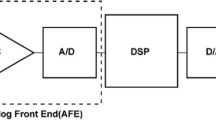Abstract
In this paper, an analog correlator based analog front end with gain control circuit for hearing aid devices is designed and fabricated with 0.18 \(\upmu \mathrm{m}\) CMOS process. The proposed analog front end consists of an analog correlator comprised of a multiplier, an integrator, and a mixed mode variable gain amplifier. The analog correlator is utilized to ensure the low input referred noise. A gain control circuit is implemented in variable gain amplifier. Based on the output of piezoelectric microphone, designed gain control circuit automatically sets the gain. The investigated analog front end offers lower noise and wider dynamic range with compact size compared to conventional architecture. It achieves a 42 \(\mathrm{n}V_{rms}\) input referred noise and 84 dB signal to noise ratio. The total area of the designed analog front end circuit is 386 \(\upmu \mathrm{m}\) \(\times\) 569 \(\upmu \mathrm{m}\). Designed circuit is interfaced with a sensor model of piezoelectric microphone and its performance is successfully verified against simulation results.


















Similar content being viewed by others
References
Willson, B. S., Tucci, D. L., Merson, M. H., & O’Donoghue, G. M. (2017). Global hearing health care: New findings and perspectives. The Lancet, 390, 2503–2515.
Kuntzmann, M. L., & Hall, N. A. (2014). Sound source localization inspired by the ears of the Ormia Ochracea. Applied Physics Letters, 105, 033701.
Kuntzman, M. L., Hewa-Kasakarage, N. N., Rocha, A., Kim, D., & Hall, N. A. (2015). Micromachined in-plane pressure-gradient piezoelectric microphones. IEEE Sensors Journal, 15, 347–1357.
Tripathi, P., Pahalwan, P., Gola, P., Pandey, N., & Pandey, R. (2016). Design of digitally controlled OTRA based filter for hearing aid application. In 2016 IEEE 1st international conference on power electronics, intelligent control and energy systems, (ICPEICES) (pp 1–5).
Hasan, S. A., Hall, S., & Marsland, J. S. (2011). A proposed sub-threshold OTA-C filter for Hearing Aids. In 2011 IEEE 9th international new circular and system conference (pp. 414–417)
Lee, H.-Y., & Luo, C.-H. (2007). Acoustic readout circuit system without highpass filter for hearing aid. Electronics Letters, 43, 659–660.
Chen, C., & Chen, L. (2019). A 79-dB SNR 1.1-mW Fully Integrated Hearing Aid SoC. Circuits, Systems and Signal Processing, 38, 893–2909.
Im, S., & Park, S. (2016). A \(154\,\mu \text{W}\), 80 dB SNDR analog to digital front end for digital hearing aids. Analog Integrated Circuits and Signal Processing, 89, 383–393.
Singh, R. K., Dhiman, R., & Chandel, R. (2015). Design and analysis of a novel automatic gain control pre-amplifier circuit for hearing aid device. In 2015 IEEE international conference on electrical, computer and communication technology (CONECCT), (pp. 1–6).
Sukumaran, A., Karanjkar, K., Jhanwar, S., Krishnapura, N., & Pavan, S. (2013). A \(1.2 \,\text{V} \,285\,\mu\text{A}\) analog front end chip for a digital hearing aid in 0.13 \(\mu\text{m}\) CMOS. In 2013 IEEE Asian solid-state circuit conference (A-SSCC) (pp. 397–400).
Serra-Graells, F., Gomez, L., & Huertas, J. L. (2004). A true-1-V 300-μW CMOS-subthreshold log-domain hearing-aid-on-chip. IEEE Journal of Solid-State Circuits, 39, 1271–1281.
Sedra, A., & Smith, K. (2004). Microelectronic circuits. London: Oxford University Press.
Allen, P. E., & Holdberg, D. R. (2002). CMOS analog circuit design. London: Oxford University Press.
Baker, R. J. (2010). CMOS: Circuit design layout simulation. New York: Wiley.
Razavi, B. (2000). A 622 Mb/s 4.5 pA//spl radic/Hz CMOS transimpedance amplifier [for optical receiver front-end]. In 2000 IEEE international solid-state circuits conference, digest of technical papers (pp. 162–163).
Chilukuri, M., Jung, S., & Chung, H.-J. (2019). A charge amplifier based complementary metal-oxide-semiconductor analog front end for piezoelectric microphones in hearing aid devices. Journal of Low Power Electronics, 15, 15–322.
Kim, S., Lee, S. J., Cho, N., Song, S., & Yoo, H. (2007). A fully integrated digital hearing-aid chip with human-factors considerations. In 2007 IEEE international solid-state circuits conference, digest of technical papers (pp. 154–593).
Acknowledgements
This paper was supported by Research Fund, Kumoh National Institute of Technology.
Author information
Authors and Affiliations
Corresponding author
Additional information
Publisher's Note
Springer Nature remains neutral with regard to jurisdictional claims in published maps and institutional affiliations.
Rights and permissions
About this article
Cite this article
Park, H., Jung, S. & Chung, HJ. An analog correlator based CMOS analog front end with digital gain control circuit for hearing aid devices. Analog Integr Circ Sig Process 105, 157–165 (2020). https://doi.org/10.1007/s10470-020-01680-3
Received:
Revised:
Accepted:
Published:
Issue Date:
DOI: https://doi.org/10.1007/s10470-020-01680-3




